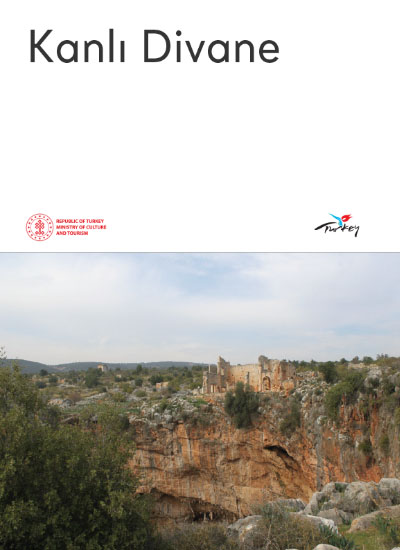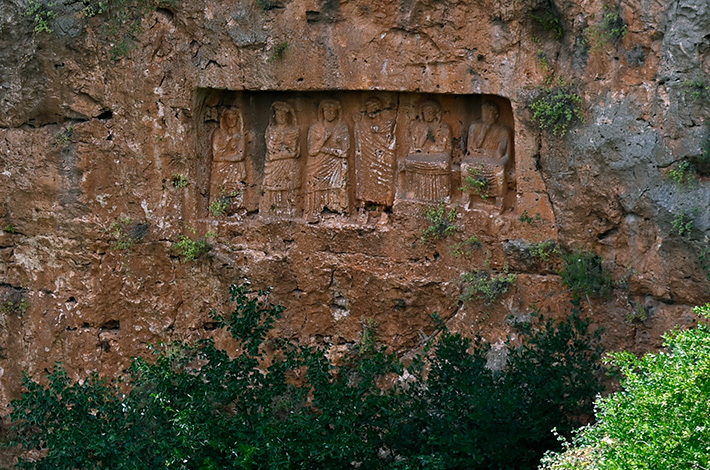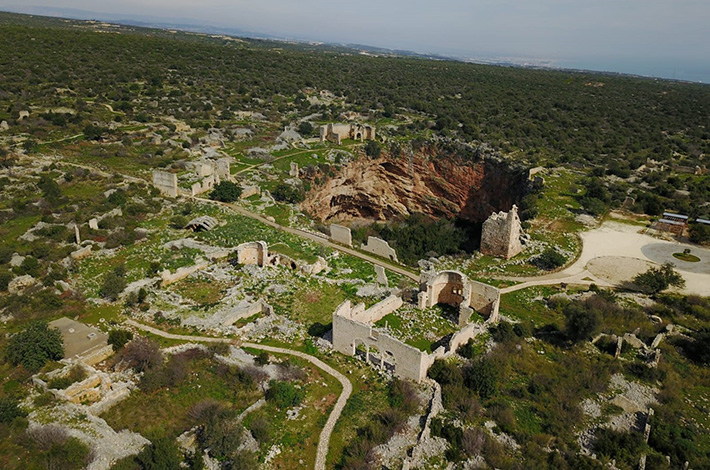The settlement of Kanytella (Kanlıdivane), which was situated within the borders of Mountainous Cilicia during the Ancient Period, is located approximately 50 km west of Mersin and 13 km west of Erdemli District. The settlement is around a large sinkhole, known as Kanlı Divane Obruk. The sinkhole, which is the centre of the ancient city, is 142 m long, 95 m wide, 413 m in circumference, 50 m deep and 12,000 square metres in area. The area was first inhabited during the Hellenistic Period (3rd century BC) and remained continuously inhabited until the Late Antique Period (7th century AD). From the 15th century onwards, Turkmen groups began to settle in the region. It is thought that the name "Kanlı Divane" is derived from the combination of the words "Kanlı" and "Divan". The former is derived from the red (kanlı) colour of the rocky structure where the city is located, while the latter is derived from the fact that the Turkmen tribes gathered in the region held their meetings (divan) here. It is also said that the name derives from the practice of leaving criminals in the sinkhole and then slaughtering them by lions. The surrounding area was subsequently covered in blood. The only Hellenistic Period structure in Kanlı Divane is a tower. According to the inscription on the tower, it was built by the priest-king Teukros, son of Tarkyaris, in the late 3rd and early 2nd century BC and dedicated to Zeus Olbios. The walls of the sinkhole are decorated with reliefs from various historical periods. On the south wall, there are three figures of a man and a woman standing side by side, and a man and a woman sitting on a higher pedestal. The inscription below the relief, dated to the 1st century AD, states that Armaronzas, the father of Hermias, had his wife and children (statues) erected. It is also stated that anyone who damages these reliefs should pay 1000 drachmas to Zeus. The relief on the north side of the sinkhole depicts a soldier holding a spear in his right hand and a sword in his left hand. The inscription of the relief states that the soldier's name is "Trogomon". It is understood that this inscription was written by the soldier's mother. In the rock graves of Çanakçı on a rock mass approximately 1 km southwest of the margin, there are relief depictions of the grave owners. Among these reliefs, the depiction of a woman mourning by grasping her chiton over her head with her right hand is noteworthy. The relief is dated between the 1st century BC and the 1st century AD. The most magnificent mausoleum of Kanytella is the tomb of Aba. The inscription on the door of this monumental tomb, which was built in the style of Roman temples, indicates that it was constructed by a woman named Aba in the name of herself and her husband Arios. The tomb monument was built on a low podium. There is a vaulted entrance on the front façade. The tomb is dated to the 2nd century AD based on the inscription and other graves. There are four important churches around the Kanlı Divane sinkhole. It is also known that a fifth church, of which only the apse is visible today, and a chapel identified during the recent surveys, existed in the settlement. The churches in the settlement were not built out of necessity but as an indicator of economic prosperity.
KANLIDİVANE ARCHAEOLOGICAL SITE




